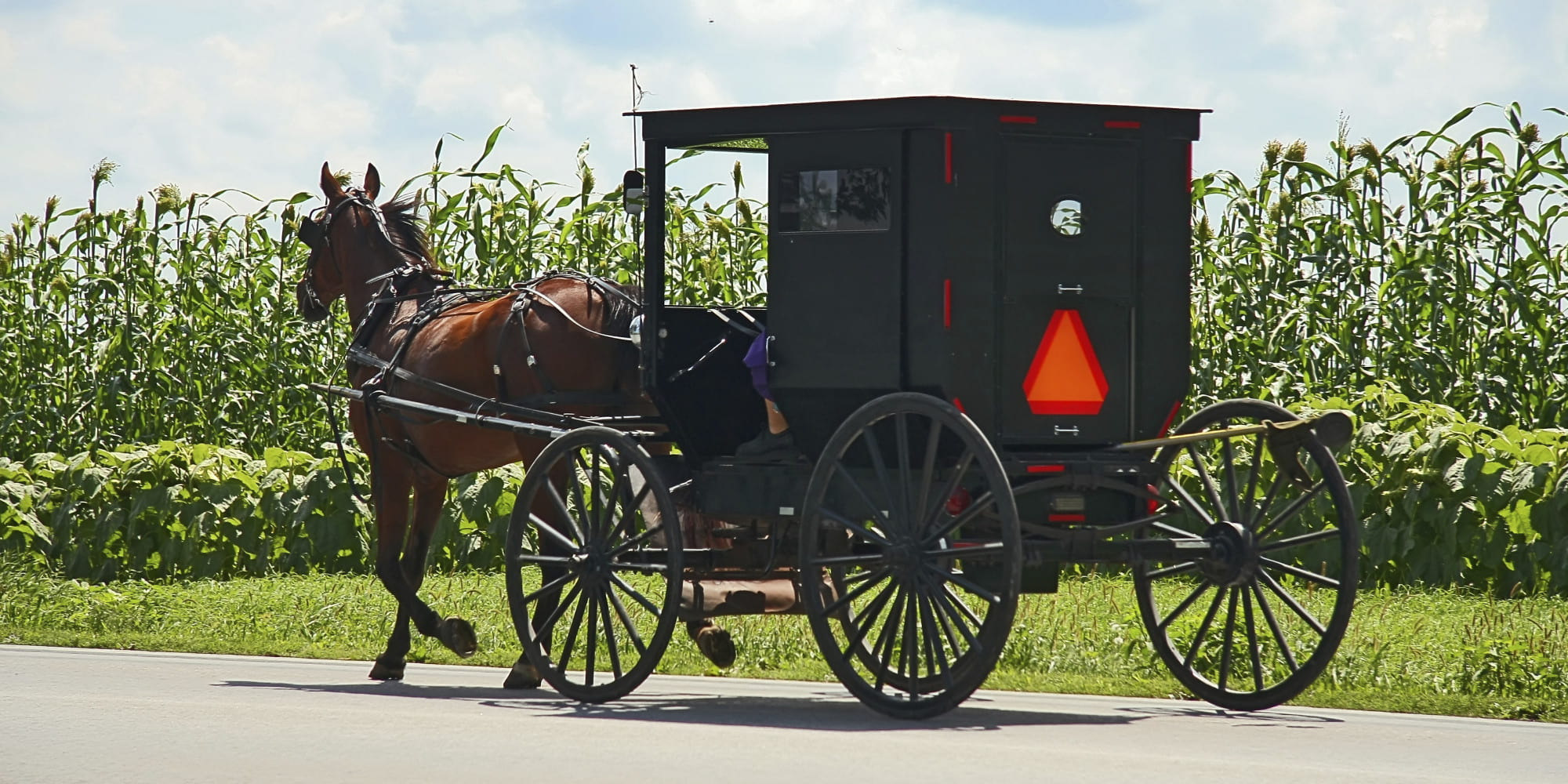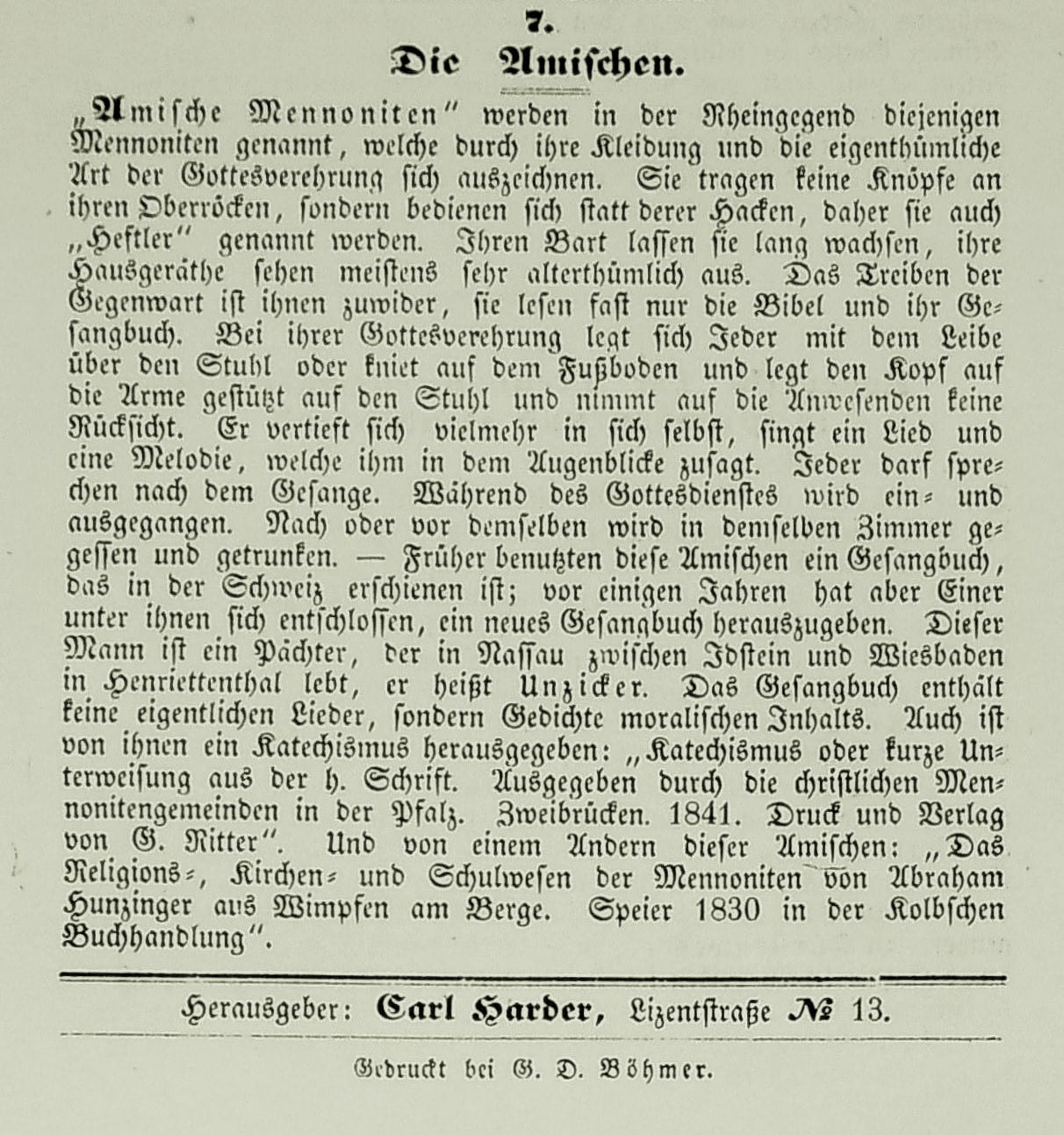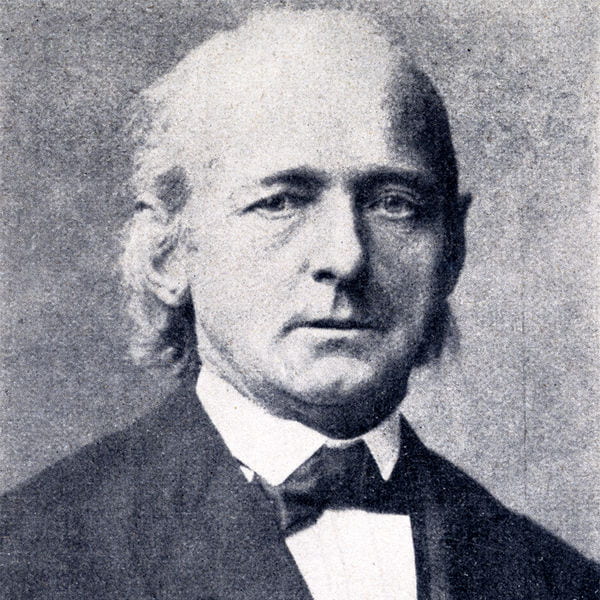by guest contributor Ben Goossen
By now the tropes are well worn: buggies, bonnets, and broad brimmed hats. Although Anabaptists around the world are incredibly diverse, ranging like many faith communities from ultraconservative to liberal-radical, popular stereotypes have long presented members as agrarian anti-modernists. Traditionalist Anabaptists, especially Amish and Old Order Mennonites who avoid cars and many forms of electricity, have come to be seen as a people temporally out of joint, time capsules of a past era. But which epoch might that be, exactly? And just how long have such notions been around?

“Horse-and-buggy” Anabaptists like the Amish are often portrayed as relics of an earlier age (Huffington Post)
Conservative Anabaptists enjoy a distinctly positive reputation today. In a time of environmentalism, minimalism, and slow food movements, their agricultural orientation and emphasis on simplicity often seem appealing. But Amish tourism was not always an American pastime. As recently as a few decades ago, observers viewed traditionalists with hostility. Widespread faith in the wonders of satellites and microwaves led many to see them as ‘backward,’ a people that ‘impeded progress for everyone’ (x). According to midcentury theories of modernization, the world was on the up-and-up. So-called advanced countries like Great Britain and the United States were pushing the boundaries of progress, while places such as Southeast Asia and sub-Saharan Africa were still scrambling to catch up. This logic presented modern technology as a rubric for measuring historical time. Like the allegedly underdeveloped countries of Cuba or Vietnam, Amish and Mennonites seemed trapped in the past.

Mennonite women with different clothing styles at the 1967 Mennonite World Conference in Amsterdam (Mennonite Church USA Archives)
For those of us looking back from a position of postmodernity, modernization theory appears not a timeless law but the product of a specific historical moment. Hence while Anabaptist groups have long distinguished themselves from external populations, the idea that this was a rejection of ‘progress’ per se emerged only in recent years. Early modern Mennonites and Amish adopted ascetic and iconoclastic theologies not to resist the future, but as a means of distancing themselves from the corruptions of the ‘world.’ Until the twentieth century, their farming communities were often among the most likely to innovate, famously leading Max Weber to pronounce Anabaptists, “whose otherworldliness is as proverbial as their wealth,” the most outstanding bearers of the “spirit of capitalism” (10).
So when did they become old-fashioned? Definitive conclusions await further inquiry. Yet assertions of Anabaptist backwardness can be found as early as the mid-nineteenth century. Take one example from within the community itself: a short 1847 article entitled “The Amish,” by liberal Mennonite elder Carl Harder (1820-1898) in provincial Prussia. Harder described the small Amish Mennonite community in the south German states, located several hundred miles away, in explicitly temporal language. In the minister’s telling, his more orthodox coreligionists had willingly distanced themselves from modernity. “Contemporary ways of life are distasteful to them,” he noted. These Amish refused to wear buttons, preferring hooks and eyes. For worship, they met in simple buildings, knelt to pray, and read only a small number of spiritual texts. Not just their churches, but also their homes and everything with which they surrounded themselves appeared, in Harder’s estimation, “quite antiquated.”

Carl Harder’s brief remarks on “The Amish.” (Monatsschrift für die evangelischen Mennoniten, October 1847, p. 16.)
In the years before the publication of Karl Marx’s major works, such opinions were almost assuredly—at least within the Anabaptist fold—atypical. The first Mennonite in the Prussian east to receive university training and return as a minister, Carl Harder was an unusual figure. After completing his studies at Danzig and Halle in 1845, he went on to become one of the most prolific Mennonite writers and publishers of the nineteenth century. For years, he tutored Prince Hermann of Wied, and he became a lifelong correspondent with the renowned poet and Queen of Romania, Carmen Sylva. In addition to weekly sermons, he delivered public lectures on “Contemporary Politics” and “Modern German Literature,” all the while advocating a new global brand of Freethinking Christian ecumenicalism. If these positions garnered Harder favor among certain Protestant intellectuals, they enraged many of his Neopietist coreligionists. In the 1850s, one assembly of Prussian Mennonite clergy temporarily stripped him of his ordination (175-181).
Given his long, often bitter personal struggle to liberalize Anabaptism, it is perhaps not surprising that Harder wrote critically of the Amish. The specific language of backwardness, however, was surely not his invention. Beginning in Protestant lecture halls and continuing through discussions with his Lichtfreunde associates, Harder had steeped himself in the discourse and logic of progress. As a fellow native of Konigsberg, he nurtured a special affinity for Immanuel Kant. The Baltic philosopher’s theory of “perpetual peace,” in particular, seemed to offer Harder a means of retaining a specifically Anabaptist interest in peacemaking while simultaneously supporting Prussian military objectives. And despite his commitment to Christian internationalism, the minister’s early enthusiasm for German unification reflected an appreciation for the philosophy of Johann Gottfried Herder. Perhaps most influential were the works of G.W.F. Hegel. Just as Harder encouraged the heirs of the Frankfurt Parliament to heed “the will of the Weltgeist,” so did he envision a Mennonitism stripped of its traditionalist trappings (Harder, “Deutschland und Preußen,” Mittheilungen aus dem religiösen Leben, September 1848, 2).
How strong is the link between Anabaptist anti-modernism and teleological views of civilization? Anabaptist thought—perhaps because of its reputation as a peasant theology—has been integrated only poorly into the study of intellectual history. Yet as illustrated by the life and writings of Carl Harder, popular depictions of Amish and Mennonites as holdovers from an earlier time may themselves be, at least partially, the legacy of major European thinkers. While much ink has been spilled over the twentieth-century aversion of conservative Anabaptists toward modernity, comparatively little is known about when or why their various positions emerged in the first place. Examining such questions from an eighteenth or nineteenth-century perspective could prove deeply revealing for historians of Anabaptism, as well as for those seeking to understand how religious radicals and reactionaries helped shape notions of modernity that are still with us today.
Ben Goossen studies modern European history at Harvard University. His research focuses on the nationalization and global migrations of German-speaking Mennonites.




April 26, 2016 at 9:52 am
Fascinating! I know of no equivalent to Carl Harder among the “Swiss” Mennonites in America. Do you?